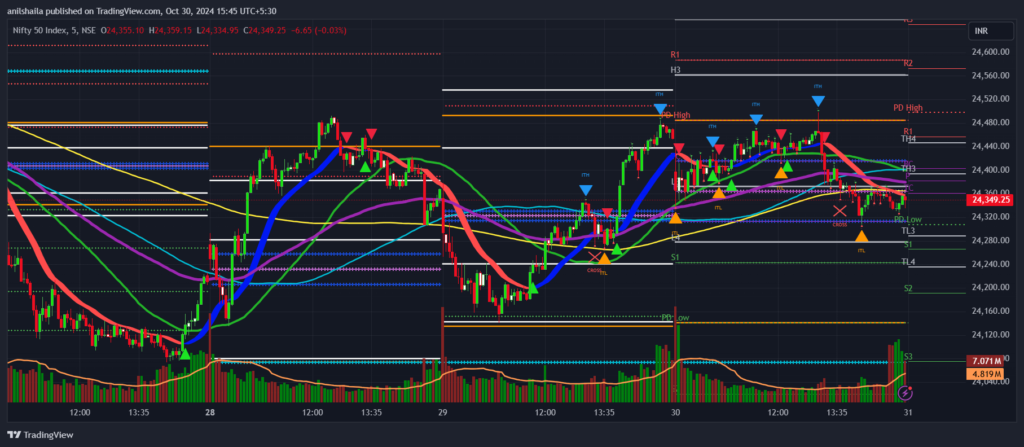
Introduction: What is CPR in Technical Analysis?
In the world of intraday trading, the Central Pivot Range (CPR) is a powerful technical indicator that assists traders in making informed decisions about price action. CPR is widely used among day traders as it helps identify potential price reversal levels, entry and exit points, and the overall market trend. If you’re looking to elevate your trading strategy, understanding and utilizing CPR can provide you with an edge in predicting price movements.
Understanding the Basics of Central Pivot Range (CPR)
The CPR indicator is derived from the previous trading day’s price levels and serves as a reference point for predicting potential support and resistance levels for the current trading session. The range consists of three main levels:
- Pivot Point (PP) – Calculated as an average of the high, low, and close prices of the previous day.
- Top Central Pivot (TC) – The midpoint between the pivot point and the high of the previous day.
- Bottom Central Pivot (BC) – The midpoint between the pivot point and the low of the previous day.
When plotted on a price chart, these levels create a range that helps traders determine key areas where price might reverse or experience significant price action. By analyzing how the current market price interacts with this range, traders can gather insights into potential buying or selling signals.
Formula for Calculating CPR
Here is the basic formula for calculating CPR:
- Pivot Point (PP) = (Previous Day’s High + Low + Close) / 3
- Top Central Pivot (TC) = (PP + Previous Day’s High) / 2
- Bottom Central Pivot (BC) = (PP + Previous Day’s Low) / 2
These levels are recalculated daily, meaning CPR provides fresh insights each trading day based on the prior day’s price action.
How to Use CPR in Intraday Trading
Now that we understand the components of CPR, let’s explore its practical application in intraday trading. CPR is mainly used for identifying market trends, potential reversal points, and critical support and resistance levels.
1. Trend Identification
CPR is a valuable tool for gauging the market trend at the start of a trading session. Here’s how traders can interpret CPR levels for trend analysis:
- Bullish Trend: When the price is consistently trading above the CPR levels, it signals a bullish trend, indicating that the market sentiment is positive.
- Bearish Trend: When the price is consistently trading below the CPR levels, it signals a bearish trend, suggesting a negative market sentiment.
- Sideways or Neutral Trend: If the price oscillates around the CPR levels without establishing a clear direction, it indicates a range-bound market.
By understanding the current trend, traders can align their strategies accordingly – either preparing to buy in a bullish trend, sell in a bearish trend, or avoid trading in a range-bound market.
2. Entry and Exit Points
One of the key applications of CPR is to determine entry and exit points. When trading intraday, having a solid entry and exit strategy can be the difference between a profitable and a losing trade. Here’s how CPR can assist in this:
- Long Trade Entry: If the price opens above CPR levels and maintains its position, this can be a strong entry signal for a long position. Confirming with other indicators like moving averages or RSI strengthens this signal.
- Short Trade Entry: When the price opens below CPR levels and continues to stay below, it indicates a short trade entry opportunity.
- Exit Points: Traders can set their exit points near the top or bottom of the CPR range, or at the next support and resistance levels beyond the CPR range, depending on the market trend and other technical indicators.
Using CPR to define entry and exit points minimizes the emotional decisions that can often lead to losses.
3. Support and Resistance Levels
CPR levels act as a framework for identifying potential support and resistance areas within a trading day:
- Resistance Levels: If the price struggles to break above the top central pivot (TC) or the pivot point (PP), these levels can act as resistance.
- Support Levels: If the price finds support at the bottom central pivot (BC) or the pivot point (PP), these levels can act as strong support zones.
Knowing where these levels lie can help traders set stop-losses and take-profits, safeguarding their trades against sudden price fluctuations.
CPR Strategies for Effective Intraday Trading
Applying the CPR indicator effectively in intraday trading involves using specific strategies to maximize returns. Here are two popular CPR-based strategies:
Strategy 1: CPR Width Analysis
The width between the top and bottom central pivots can indicate the day’s potential price movement range:
- Wide CPR: When the CPR range is wide, it indicates lower volatility. This may mean that price movements could be relatively smaller, and breakout opportunities may be limited.
- Narrow CPR: A narrow CPR range indicates higher volatility and increases the likelihood of breakouts. Traders may look to capitalize on potential breakout scenarios, as narrow CPR levels often precede sharp price movements.
Strategy 2: CPR Breakout Strategy
In this strategy, traders look for price action that moves beyond the CPR range:
- Upward Breakout: When the price breaks above the top central pivot, it can signal a potential bullish breakout, especially when confirmed with volume and other indicators.
- Downward Breakout: A downward breakout below the bottom central pivot suggests a bearish trend, and traders might enter short positions.
CPR breakout strategies are popular for capturing momentum trades, particularly in high-volatility markets.
Advantages and Limitations of Using CPR
Advantages:
- Easy to Calculate: CPR is based on simple calculations using previous day’s high, low, and close prices.
- Versatile: CPR levels can be used across all market conditions and asset classes, from equities to forex and commodities.
- Intraday Focused: CPR is recalculated daily, making it a reliable tool for day traders who rely on up-to-date data.
Limitations:
- Lagging Indicator: CPR uses past price action and may not always reflect sudden news or major events.
- Not Standalone: It’s essential to confirm CPR signals with other indicators like RSI, MACD, or moving averages to avoid false signals.
Conclusion: Master the Art of Intraday Trading with CPR
The Central Pivot Range is a practical tool for intraday traders looking to predict price action and gain a comprehensive understanding of market trends. Whether you’re a beginner or an experienced trader, incorporating CPR into your trading strategy can enhance your ability to identify key support and resistance levels, make informed entry and exit decisions, and anticipate potential price movements. As with any technical analysis tool, CPR works best when combined with other indicators to create a well-rounded trading strategy.
Explore the potential of CPR to refine your trading strategies and see how this unique indicator can contribute to consistent trading success.
Explore more insightful articles and stock analysis and Technical Analysis on asbfinance.in, your partner in financial education, powered by AngelOne Limited. Happy investing!

